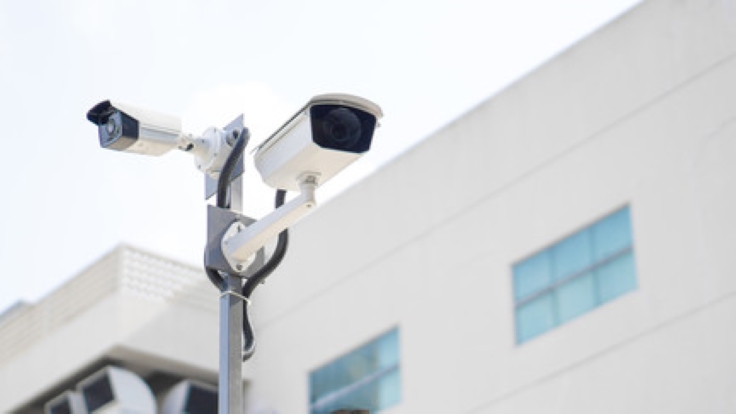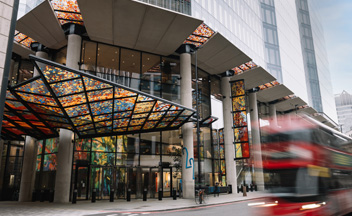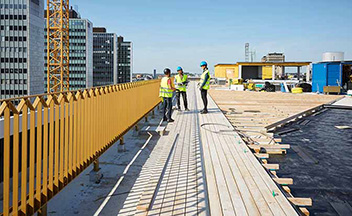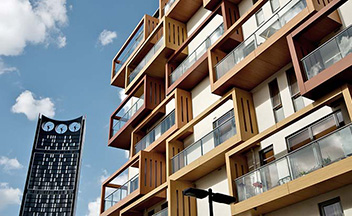Burglary and theft are the most common crimes suffered by UK businesses. If you manage commercial premises, it's important to keep your property safe from criminals. Fortunately, there are plenty of measures you can take to tighten security.
This article will explore the importance of properly securing your site, key risk factors, and controls to consider.

The effects of commercial property crime
Commercial premises may be a target for criminals, often resulting in serious financial loss. According to the 2023 Commercial Victimisation Survey, 409,000 businesses experienced criminal activity. This equated to 26% of total UK businesses, down from 28% in 2022. However, the number of commercial premises in the country increased over that period.
Last year, the most prevalant crimes encountered by businesses were:
- Theft (14%)
- Burglary (8%)
- Vandalism (8%)
- Assaults against employees or customers (7%)
Theft and burglary topped the types of crimes faced by businesses in 2022 too, with 15% and 9% shares of total crimes. 9% of locations with a computer also suffered at least one cyber crime offence. These ranged from receiving fraudulant emails to hacking scams.
Industries that were commonly targeted included:
- Wholesale and retails (41%)
- Transport, accommodation and food (32%)
- Primary and utilities (32%)
- Other services (28%)
Financial impact
A 2022 survey indicated that 45% of victims suffered significant financial loss as a result of commercial property crime. 33% of businesses reported having to pay for additional staff time to deal with the incident. Others said that the crime prevented their business from carrying out normal activities.
In 2023, 63% of victims disclosed moderate financial impact, although no premises had to close as a result. Notably, close to a fifth of larger businesses in London lost up to £50,000 due to criminal activities. Some premises were not insured to the full amount of their losses, implying that they had the wrong level of cover.
Understanding the risks
Several factors might increase the likelihood of a business falling victim to crime, such as:
1. Location
Location is a major indicator of theft vulnerability. Sites based near areas with higher crime rates have more chance of experiencing theft or burglaries. You could implement steps to secure your premises, especially if it houses expensive stock or equipment.
Prevention still matters if your business is in an area without much crime, as it can happen anywhere. Rural theft cost the UK £49.5 million in 2022 and that continues to increase today. Even the most rural areas had 16 robberies per 100,000 population. Urban areas with major conurbations recorded 194 offences per 100,000 population.
2. Size and type of business
Combined data from 2022 and 2023 showed that the wholesale sector experienced more crime than any other industry. Wholesalers have seen incidents jump 30% in the last 3 years as black market demand grows for common groceries. Activities also included raids of depots and goods in transit.
Large premises of 50 or more employees suffered higher crime rates than smaller sites. Theft and assaults were the most common crimes amongst medium and large businesses. This might be because they held more stock or equipment. Still, small UK businesses say that traditional crimes cost them over £10,000 from January 2021 to January 2023.
Physical security measures
There are a number of ways to counter unwanted intruders.
1. Secure entry points
Entry points are often the first port of call for thieves trying to access your property. Ensure doors, doorframes and windows are in sound condition and consider window shutters or grilles for accessible windows.
Dead locks are recommended for doors into sensitive areas containing valuables or confidential data. Include other potential entry points such as roller shutter doors and also check emergency exits. You should confirm that they have suitable exit devices and hinge bolts.
Locksmiths are able to install high-security locks designed for commercial spaces. These should meet one of the recognised kitemark standards that locksmiths can advise on.
2. Surveillance systems
Advanced security cameras often act as a powerful deterrent. Criminals are less likely to attempt theft when they know they're under surveillance or being recorded. Identify high-risk areas and place cameras near entry and exit points and blind spots. Some video surveillance systems include detector activation that immediately alerts someone to unexpected movements.
Smaller businesses usually have smaller budgets. This can result in fewer safeguards against thieves and burglars. A robust security camera might be a more cost-effective option, with solutions to a range of break-in threats.
3. Alarms
Alarm systems are designed to detect and alert to unauthorised entry into a building. They operate through a combination of sensors, control panels and communication devices. These should be strategically placed by doors, windows and other entry points to discourage intruders.
It's a good idea to connect any alarms using dual path signalling, like a SIM card and broadband line. This allows you to have the alarm remotely monitored by alarm response centres for 24/7 security coverage and quick emergency response. Accredited suppliers can support with installation and should be used to install and maintain your alarm system to the appropriate security standards (EN 50131 and EN 50136).
If done to the appropriate standard (BS 8243), you can arrange for a formal police response. Ensure that your keyholders respond safely and in good time to alarm activations. Alarm companies will usually try to meet your local circumstances.
4. Lighting
Adding commercial lighting to your business premises might enhance employee safety. Timed or motion-activated lights give the appearance of occupancy.
Adequate lighting in parking areas and walkways also deters thieves during late-night shifts. They also improve the effectiveness of existing security cameras by providing clearer footage.
Access controls
1. Employees access control
Door card readers and biometric identity systems scan and log people's credentials when coming in and out of the building. These may prove useful for sites that stay open after daylight hours.
Different types of readers are available depending on the level of security required. For example, PIN codes, key fobs, mobile apps and cards. It's important to regularly update access permissions and revoke access for former employees. Remember that such locks are designed to control access, so buildings should still be physically secured out of hours.
2. Visitor management
Sign-in and sign-out procedures should be established. Especially for visitors, contractors and delivery personnel. Best practice usually comprises offering visitor badges to those outside the business.
Some visitor management processes may be moved to cloud or software-based systems. You can then easily track visitor information and even reduce waiting times. All information gets stored in one place. You may prefer to restrict access to sensitive areas of the premises.
Finally, you could consider forensic marking tools to check visitor identification. Tools, like Smartwater, come equipped with warning labels to deter thieves.
Cyber security
1. Protect digital assets
Wireless cameras are often vulnerable to hacking if not secured. Attackers could gain access to the video feed or control the camera.
You should also be mindful of data interception, where wireless signals are hijacked. Interceptions can lead to data breaches where criminals gain access to sensitive information.
The best way around this is to set up two-factor authentication. Setup an account and request a password for extra security. Passwords should also be changed frequently but avoid easy-to-guess phrases. In addition, using accredited companies to install and maintain your security systems will further reduce risk.
2. Network security
Create firewalls and virtual private networks (VPN) for all digital devices connected to your security system. These will safeguard against data breaches.
Firewalls control incoming and outgoing traffic on your networks, blocking any suspicious software. Remote VPN gives remote access to company networks to individual hosts, such as remote users. Organisations with multiple sites can use VPNs to provide access to corporate email and file services.
Privacy of sensitive information is ensured through multi-factor authentication and data encryption.
3. Employee training
Equip your employees with the tools, knowledge and support to counter cyber security attacks. Conducting regular training around phishing or malware may help prevent data breaches. With cyber attacks becoming more sophisticated, this could save your business money in the long run.
Training also creates a culture of security, with risk management at the heart of your company values. Employees should feel empowered to identify and report suspicious activity. Seek formal certification to meet training standards, such as ISO 27001 or the Cyber Essentials scheme.
Operational practices
1. Inventory management
Creating robust inventory control measures and protocols can stop criminals in their tracks. Educate employees about the importance of inventory security when reporting suspicious behaviour.
Also try to restrict access to sensitive areas of the premises, like storage facilities. Barriers, locks and surveillance systems are just some physical deterrents.
If you wish to track items in real-time, you can invest in inventory management software. Barcode scanning, digital labelling and audits are some ways to better manage your inventory.
2. Cash handling procedures
If your business collects large amounts of cash, give special attention to how the money is handled. Train staff to avoid leaving drawers and safes open longer than needed. You may also want to keep at least one member of your staff at hand when money is moved or counted.
Electronic surveillance is useful but can’t stop a theft from happening in the first place, unlike a safe. Deposit drop safes allow authorised staff to store cash without use of a key or access code. You can choose from simple front loading deposit safes to rotary drum safes. A rotary drum safe is ideal for storing large amounts of cash due to the extra layer of security it provides.
3. Security audits
Security audits are a comprehensive way to assess the physical security measures you have in place. They help identify potential vulnerabilities to enhance the security of the premises. A thorough security audit typically looks at:
- Access control systems
- Alarm and surveillance systems
- Perimeter security
- Security lighting
- Key and lock management
- Incident response
- Employee awareness and security personnel
For larger organisations, it may be useful to setup professional security audits on a regular basis.
Insurance considerations
1. Adequate cover
Before purchasing a theft insurance policy, evaluate your company’s existing security measures. This will guide you when choosing the right level of cover for your business.
Our commercial crime insurance offers a comprehensive all-risks policy. It aims to cover financial losses, including theft by a third-party. Our extensive coverage includes theft carried out by anyone, inside or outside of your business.
2. Filing claims
If your business falls victim to criminal activity, report the theft and provide evidence to your insurance provider. This should include a list of stolen items, proof of ownership, and any relevant security footage.
If the worst happens and you need to make a claim, our experienced claims team will act decisively when you need it most.



